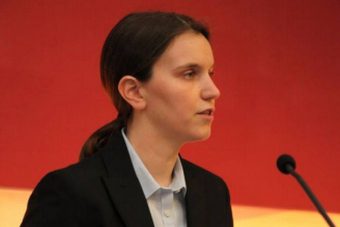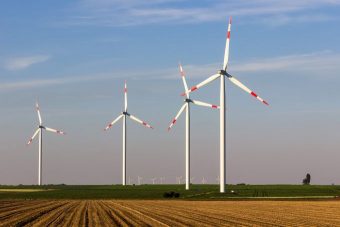
During the Energy and investments fair in Novi Sad the editorial office of ENERGETSKI PORTAL had a pleasure to attend the exposition of Ms Anna Boulos, the economic counsellor at the US Embassy in Belgrade, at the conference: “Energy Prospects and Challenges”. Her presentation was mostly devoted to fossil fuels, gas and the fact that Serbia depends on the import of gas from Russia, which makes Serbia energy uncertain according to her cognition. Serbia is, according to her words, in the lowest D category of energy independence. Due to this fact, we have asked Ms Boulos to tell us something more about renewable energy sources and how the United States see Serbia in this regard.
EP: Minister for Energy and mining, Mr Aleksandar Antić, has recently announced that the regulation which enables the use of energy from renewable sources was adopted. It is planned that the level of energy usage from renewable sources reaches 27% by 2020. How do you comment this announcement and the set deadlines?
Anna Boulos: As a part of the Energy Community, Serbia has committed itself to using 27% of final total energy consumption from renewable sources by 2020, and the current percentage is 22. For the last two years which I have spent in Belgrade, Serbia has not significantly increased the share of renewable energy in its energy system. However, I absolutely believe that this is realistic goal for Serbia, provided that the Government takes necessary steps in order to promote renewable energy. To begin with, Serbia has significant potentials for the use of renewable energy sources, but it uses only one-third of these resources. So, if the Government could support the investments in renewable energy, it would be very easy for Serbia to reach its goal by 2020, and not only to reach it but also to become a regional leader. Due to all this the Minister’s statement on adoption of regulation for renewable sources is very encouraging, since this regulation will allow Serbia to develop its potential for renewable energy. When the government adopts investment friendly and sustainable model of contract for the purchase of electricity for the power plants with the installed capacity of over 50 MW, the investors in the field of renewable energy will begin to develop bigger projects in Serbia.
Another reason, due to which I believe that the goal for 2020 is possible, is because unfortunately Serbia is energy inefficient. Although the increase in production of renewable energy is important and necessary for Serbia to achieve its goals by 2020, there is another way to achieve this goal and that is energy efficiency. Serbia consumes 2.7 times more energy per unit of energy consumption than the average country member of Organization for Economic Cooperation and Development (OECD). If Serbia would invest in energy efficiency measures such as modernization of local heating systems with the technology which is more energy efficient, of using more efficient materials and better insulation materials in buildings, than it could reduce its energy consumption and it would make a significant progress towards its goals by 2020.
EP: What is the ratio of the use of energy from renewable sources and non-renewable sources in the United States? Do you know whether there is any cooperation between the Ministry and the services in the USA and Serbia and is there exchange of experiences in the field of renewable energy sources?
Anna Boulos: In 2015, the renewable sources accounted for approximately 11 percent of total energy production in the USA, and nuclear power accounted for about 8 percent. Fossil fuels continue to represent a major part of our production and energy consumption, but when you have a look at new energy capacities in the USA, the renewable energy sources prevail.
Renewable energy takes up 68 percent of all newly installed capacities in the USA in 2015, and our CO2 emission have fallen to the lowest annual level since the mid-nineties. Our energy sector has gained an additional 8.5 GW of wind power plants and 7.3 GW of new solar power plants. The USA also records an increase in investments in renewable energy. Investments in clean energy reached $ 56 billion in 2015, thus I think we can say that investors in the USA realise that the clean renewable energy is the energy of the future.

Our Embassy has financed through USAID the exchange programmes for the Energy Agency of the Republic of Serbia. For example, in 2007 the US National Association of Regulatory Utility Commissioners (NARUC) has helped the Government of Serbia to establish the Energy Agency of the Republic of Serbia (AERS). Then, USAID helped AERS to establish a partnership with Pennsylvania’s Public Utility Commission in the USA. This partnership lasted till 2011 and it helped the strengthening of AERS’s capacities. In addition to exchange programmes, the USAID has been providing significant technical assistance to the Government of Serbia in the field of energy. It gave them guidelines for the increase of energy efficiency and the performance of local heating systems by switching to sustainable biomass, which reduces pollution and promotes sustainable forestry. USAID also connects two regional working groups – one for planning regional electricity transmission and the other for energy supply security – in order to develop good practices and strengthen the energy infrastructure, especially regarding the integration of renewable energy sources. EMS, EPS and AERS participate in these working groups.
EP: Do the Embassy and the USA funds support the legislation reform in the energy sector in Serbia, and in what way?
Anna Boulos: Yes, absolutely. Our Embassy has worked, again through USAID, with the Government on legislation of energy sector in Serbia. As I have already mentioned, USAID helped the Government to establish AERS. Also, our National Association of Regulatory Utility Commissioners (NARUC) supports AERS and other energy regulators in the region in identifying regulatory and legislative changes which are necessary for the liberalization of the electricity market, as it is required by the Treaty on establishing the Energy Community. Last year in January, USAID helped the Ministry of mining and energy in the analysis of model contract on the purchase of electricity from RES.
EP: Are there any plans for the investments from the USA in the renewable energy sources in Serbia, maybe in wind farms or solar power plants?
Anna Boulos: Definitely, yes. American company Continental Wind Partners (CWP) is ready to continue a project that will develop wind farm 158.4 MW as soon as the Government adopts the investment friendly and sustainable model of contract on the purchase of electrical energy from wind energy. CWP will invest over 40 million Euros and hire around 400 people for the construction of Wind Park.
CWP, together with River Power Solutions, is also interested in entering the public-private partnership with the city of Belgrade and also in other cities in Serbia, in order to produce heat by using the energy of river flow through the heat pump. CWP’s heat pump would take over the energy from the river flow – from only a few degrees of heat – and it would use it as sustainable alternative to the use of natural gas. It is a very interesting technology which works in a similar way as cooling where the cold air is used for the cooling of the objects. I think this is a brilliant way for Serbia to utilize its natural resources, and it is unbelievable that such technology exists! The technology that uses cold water from the river in order to heat your own homes! Taking into account the amount of potentials that Serbia has in the field of renewable energy and that unfortunately Serbia uses only third of its own potential, I would not be surprised if many international investors including American companies would start coming here as soon as the Government adopts legislative framework which supports the investments in the field of renewable energy sources.
Interview by: Vesna Vukajlović
This interview was first published in bulletin “Renewable Energy” on June 1st 2016.



